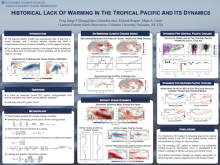Historical Subsurface Cooling in the Tropical Pacific and its Dynamics
Feng
Jiang
Lamont Doherty Earth Observatory, Columbia University
Poster
Understanding how the tropical Pacific responds to rising greenhouse gases (GHGs) in recent decades is of paramount importance given its pivotal role in global climate systems. Extensive research has explored the influence of GHGs on tropical Pacific sea surface temperatures (SST) and the overlying atmosphere, yet the historical change of the upper ocean has received far less attention, despite its substantial impact on SST and consequently the global atmosphere. In this study, we present compelling evidence of a consistent subsurface cooling pattern along the thermocline in the central-to-eastern tropical Pacific since 1958 based on multiple sets of observational and reanalysis datasets. This thermocline cooling has been argued to be contributing to the observed cooling or lack of warming of the equatorial cold tongue SST. Here we establish that this cooling is primarily linked to the dynamical adjustment of ocean currents in response to tropical surface wind stress changes. In the central-to-eastern equatorial Pacific and the southeastern off-equatorial Pacific, where zonal wind stress exhibits a strengthening trend, a pronounced subsurface cooling trend emerges just above the thermocline that is closely tied to increased Ekman pumping. In the eastern equatorial Pacific where zonal wind stress weakens, the westward surface current and eastward equatorial undercurrent weaken as well, resulting in reduced vertical current shear and increased stratification, which suppresses vertical mixing and leads to local cooling. In contrast, the contribution of meridional overturning circulation change to the observed subsurface cooling trend is relatively minor. We also analyze a wide range of coupled climate model simulations for the historical period, and investigate potential reasons for these models to underestimate or misrepresent the upper ocean's response to GHGs forcing. Finally, we discuss how this subsurface cooling communicates with the surface and helps shape the SST pattern in response to GHGs forcing, and how biases in simulating subsurface dynamical adjustment compromise the reliability of past simulations and projections of tropical Pacific and its global impacts on regional climates, climate sensitivity, tropical cyclones, the carbon cycle, and potentially more.

Poster file
feng-jiang-confronting-poster.pdf
(9.4 MB)
